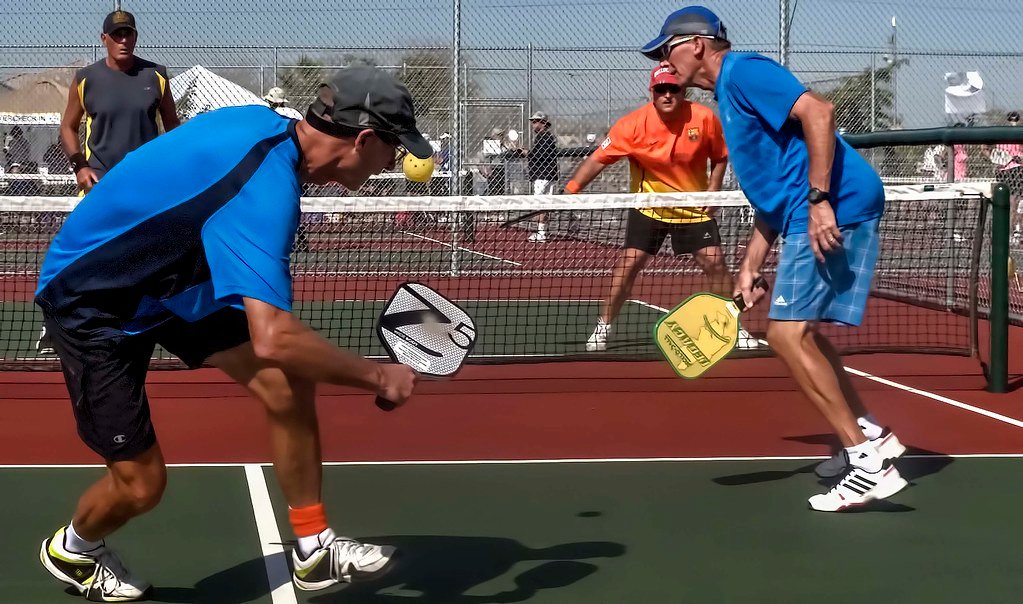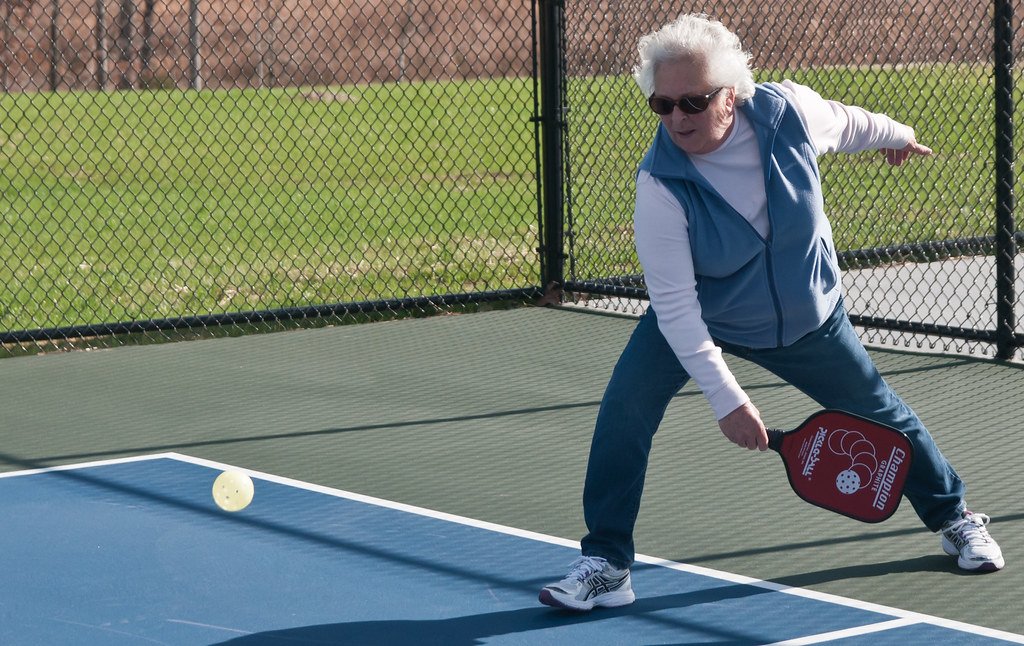Beneath the vibrant sun-soaked skies, where small plastic balls dance across a court, an intriguing battle of skill and strategy unfolds. It is the world of pickleball, a relatively young sport that has taken the athletic community by storm. Within this rapidly growing pickleball community, the question of gender participation emerges, provoking curiosity about the dynamics between men and women on the court. In a game where agility and finesse reign supreme, the contest extends far beyond the boundaries of physical prowess. In this article, we delve into the intricacies of gender participation in pickleball, unraveling the complexities that lie within the harmonious and sometimes divergent realms of men and women in this peculiar, yet invigorating sport.
Table of Contents
- - The Rise in Popularity of Pickleball: Exploring Gender Participation and Trends
- – Gender Differences in Skill Levels and Gameplay Strategies: A Deep Dive into Men’s and Women’s Performance
- – Barriers and Challenges: Analyzing Factors Limiting Gender Participation in Pickleball
- – Overcoming Stereotypes and Promoting Inclusive Environment: Encouraging Equal Opportunity in Pickleball
- – Implementing Strategies for Increased Gender Diversity: Recommendations for Achieving Balanced Participation in the Sport
- Q&A
- Future Outlook

– The Rise in Popularity of Pickleball: Exploring Gender Participation and Trends
The Rise in Popularity of Pickleball: Exploring Gender Participation and Trends
Pickleball, a fast-paced racquet sport that combines elements of tennis, badminton, and table tennis, has been gaining significant momentum in recent years. Its appeal lies in its accessibility for players of all ages and skill levels. While initially more popular among older adults, the sport has seen a surge in popularity among younger generations as well.
One of the intriguing aspects of pickleball’s rise in popularity is the significant increase in gender participation. Traditionally, racquet sports have been heavily dominated by male players, but pickleball has broken this trend. Both men and women have embraced the sport, and it has become quite common to see mixed-gender matches and tournaments. This inclusivity contributes to the sport’s appeal and is a positive step towards gender equality in the world of sports.
Several factors contribute to the growing popularity of pickleball. Firstly, its quick learning curve allows beginners to grasp the basics and start playing enjoyable matches relatively quickly. Additionally, the sport can be played in various settings, including indoor and outdoor courts, making it adaptable to different climates and accessible for year-round play. Lastly, the friendly and social atmosphere that pickleball fosters further attracts players of all backgrounds, enhancing the overall experience.
- Gender participation in pickleball has increased significantly.
- Pickleball’s inclusivity contributes to its appeal.
- The sport’s accessibility and social aspect attract players of all ages and skill levels.
- Quick learning curve allows beginners to start playing enjoyable matches relatively quickly.
- Pickleball can be played in various settings, making it adaptable and accessible year-round.

– Gender Differences in Skill Levels and Gameplay Strategies: A Deep Dive into Men’s and Women’s Performance
Exploring the realm of gaming, one topic that often arises is the notion of gender differences in skill levels and gameplay strategies. While it is crucial to avoid generalizations and recognize that individual talent varies, certain patterns do emerge when analyzing men’s and women’s performance in the gaming sphere.
Men’s Performance:
- Men tend to exhibit a greater inclination towards competitive gaming, often driven by their desire to dominate the leaderboard. This drive for dominance can lead to an aggressive playstyle, characterized by a focus on precise execution and high-risk maneuvers.
- When it comes to skill levels, men generally excel in areas requiring exceptional hand-eye coordination, quick reflexes, and strategic decision-making.
- Men are more likely to invest considerable time and effort into mastering complex gaming mechanics and intricacies. Their willingness to extensively study game strategies gives them an edge in understanding the finer details of a game.
Women’s Performance:
- Women often bring a different approach to gaming, emphasizing cooperation, team dynamics, and communication. Collaboration and building supportive communities are key elements that women excel at in multiplayer games.
- While women may exhibit slightly lower skill levels in areas demanding rapid reaction times, they compensate by excelling in strategy development, long-term planning, and adaptability.
- Women tend to prioritize the well-being of the gaming community, frequently engaging in initiatives that foster inclusivity and discourage toxicity. This focus on fostering positive environments enhances gameplay experiences for all.
When examining gender differences in skill levels and gameplay strategies, it is crucial to appreciate the diverse strengths and approaches that both men and women bring to the gaming table. Rather than reinforcing stereotypes, acknowledging and celebrating these differences can lead to a more inclusive and engaging gaming landscape.

– Barriers and Challenges: Analyzing Factors Limiting Gender Participation in Pickleball
Barriers and Challenges: Analyzing Factors Limiting Gender Participation in Pickleball
When it comes to gender participation in pickleball, there are several barriers and challenges that need to be acknowledged and addressed. By analyzing these factors, we can gain a better understanding of why gender disparities persist in this sport, and work towards creating a more inclusive and equitable playing field.
Social norms and stereotypes: In many societies, there are deeply ingrained social norms and stereotypes that influence individuals’ choices and attitudes towards sports. These preconceived notions often lead to the perpetuation of gender inequalities in pickleball, with women being discouraged or even excluded from participating due to the perception that it is a predominantly male sport.
Lack of representation: The lack of gender diversity in pickleball leadership, coaching, and media coverage also contributes to the limited participation of women in the sport. When women are not adequately represented in decision-making roles or given platforms to showcase their skills, it hinders their motivation and confidence to engage in pickleball.
Unequal access to resources: Another significant factor limiting gender participation in pickleball is the unequal access to resources and opportunities. This includes disparities in funding, facilities, training, and equipment. Without equal access to these resources, women face additional challenges in developing their skills and competing at a high level.
– Overcoming Stereotypes and Promoting Inclusive Environment: Encouraging Equal Opportunity in Pickleball
When it comes to pickleball, it is crucial to overcome stereotypes and promote an inclusive environment that encourages equal opportunity for all players. This means breaking down barriers and creating a space where individuals of different backgrounds can come together and enjoy the game without any preconceived notions or biases.
One way to achieve this is by actively challenging stereotypes associated with pickleball. By highlighting the diverse range of players who excel in the sport, we can dispel any misconceptions and showcase the true inclusivity of the game. Whether it’s age, gender, or physical ability, every player deserves the chance to participate and thrive in the pickleball community.
To foster an inclusive environment, it is essential to provide equal opportunities for all players. This can be done by organizing diverse pickleball events that cater to different skill levels, ensuring everyone feels welcome and valued. Additionally, creating mentorship programs that pair experienced players with newcomers can cultivate a supportive community where knowledge and skills are shared. By embracing diversity and inclusivity, we can shape a pickleball landscape that celebrates the unique strengths and contributions of every individual.
Ways to promote inclusivity in pickleball:
- Organize workshops and training sessions to educate players about the importance of equality and inclusivity.
- Establish guidelines and policies that prohibit discrimination, harassment, or bias on and off the court.
- Create opportunities for players from marginalized communities to participate and excel in pickleball through scholarships or dedicated programs.
- Foster a culture of respect, empathy, and understanding among players and encourage open dialogue to address any concerns or issues that arise.
- Partner with organizations that promote diversity and inclusion, leveraging their resources and expertise.
Pickleball is more than just a game; it is a platform that can drive social change and promote equal opportunity. By actively challenging stereotypes, providing equal opportunities, and fostering an inclusive environment, we can create a pickleball community that embraces diversity and ensures that everyone has a fair chance to participate, grow, and succeed.
– Implementing Strategies for Increased Gender Diversity: Recommendations for Achieving Balanced Participation in the Sport
Implementing Strategies for Increased Gender Diversity: Recommendations for Achieving Balanced Participation in the Sport
In order to achieve balanced participation in sports, it is essential to implement strategies that promote and foster increased gender diversity. Here are some actionable recommendations:
- 1. Create inclusive environments: Establish an inclusive atmosphere within the sport that encourages and supports gender diversity. Foster a culture of respect, equality, and open communication where individuals of all genders feel valued and included.
- 2. Promote mentorship programs: Implement mentorship programs aimed at connecting experienced athletes or coaches with aspiring talents from underrepresented genders. This will provide guidance, support, and opportunities for growth, helping bridge the gender gap in the sport.
- 3. Offer equal resources and opportunities: Ensure equal access to resources, funding, training facilities, and competitions for athletes of all genders. By providing an equitable playing field, it will encourage greater participation and talent development amongst individuals who may have previously faced barriers.
- 4. Educate and challenge stereotypes: Take proactive steps to educate stakeholders, including athletes, coaches, and fans, about gender equality and challenge harmful stereotypes. Raise awareness through workshops, campaigns, and media initiatives that celebrate the achievements of athletes from diverse backgrounds.
- 5. Support grassroots initiatives: Invest resources in grassroots initiatives that focus on encouraging sport participation among the underrepresented gender. These initiatives can include community programs, school partnerships, and skill-building workshops to nurture talent from a young age.
By implementing these strategies, the sports industry can take significant strides towards achieving gender balance and creating a more inclusive environment for athletes of all genders.
Q&A
What is pickleball?
Pickleball is a paddle sport that combines elements of tennis, badminton, and table tennis. It is played with a paddle and a plastic ball on a court that is similar to a tennis court, but smaller in size.
Are there any gender differences in pickleball participation?
Yes, there are some gender differences in pickleball participation. While the sport is popular among both men and women, there may be variations in the number of participants and skill levels between the two genders.
Do men generally have an advantage over women in pickleball?
It is often suggested that men may have a slight advantage in pickleball due to their physical strength and power. However, pickleball is a sport that also values strategy, finesse, and agility, which can level the playing field for both genders.
What are some reasons for the gender participation gap in pickleball?
The gender participation gap in pickleball may be due to a variety of factors such as social norms, differing interests, and access to facilities. Additionally, historical sporting biases and stereotypes may also play a role in the gap.
Are there any efforts to bridge the gender participation gap in pickleball?
Yes, there are ongoing efforts to bridge the gender participation gap in pickleball. Many organizations actively promote inclusivity and equal opportunities for both men and women in the sport through various initiatives, tournaments, and programs.
What can be done to encourage more women to participate in pickleball?
To encourage more women to participate in pickleball, it is essential to create a welcoming and supportive environment. This can be achieved through initiatives like women-only clinics, mentorship programs, and campaigns that showcase successful female players.
Are there any benefits to increasing gender participation in pickleball?
Increasing gender participation in pickleball can have several benefits, including fostering diversity, promoting gender equality in sports, and creating a more balanced and competitive playing field. It also enriches the overall pickleball community, allowing for a greater exchange of skills and experiences.
Future Outlook
In the game of pickleball, an arena where skills, strategy, and camaraderie intersect, one cannot help but notice the distinct nuances between men and women’s participation. As we delved into the world of this emerging sport, we discovered a beautiful tapestry of diversity, intricate dynamics, and a shared passion that transcends gender boundaries.
Pickleball, a sport born out of humble beginnings and now finding a home in countless communities worldwide, provides a unique platform for individuals to challenge themselves physically and mentally. In examining gender participation, we peeled back the layers, aiming to explore the factors that might influence the game’s dynamics and uncover the truths that lay hidden beneath.
Throughout our journey, we encountered numerous anecdotes, awe-inspiring stories, and thought-provoking insights. It became evident that within the world of pickleball, both men and women bring their distinct set of skills and approaches to the court, creating an orchestra of diversity.
From our research, we witnessed men’s remarkable quickness and agility in their movement, using their physical prowess to gain an edge. Their powerful shots and acrobatic dives showcased their determination and relentless pursuit of victory. It is a testament to their dedication and sheer will to conquer any obstacle in their path.
On the other hand, women’s finesse, craftiness, and strategic precision shone brightly, often leaving their opponents bewildered. Their deft touch and uncanny ability to control the flow of the game showcased their acute understanding of the sport’s intricacies. It was a dance of grace and intellect, a testament to their dedication and unwavering composure.
But within this dichotomy of sporting attributes, we found a deeper common thread. Pickleball is a sport that unites individuals, transcending gender boundaries, age gaps, and skill levels. It fosters a sense of community where competition intertwines with collaboration, forming bonds that extend beyond the court.
In analyzing the gender participation in pickleball, it is essential to acknowledge the intrinsic worth of each player, irrespective of gender. This examination is not meant to pit men against women or engage in a debate about superiority. It seeks to embrace the unique contributions each gender makes and appreciate the diverse tapestry they create together.
In conclusion, the gender dynamics within pickleball reflect the broader socio-cultural landscape, highlighting the importance of equality, understanding, and celebration of each individual’s inherent worth. With every pick of the paddle, both men and women weave together a story of passion, resilience, and community, leaving an indelible mark on the canvas of pickleball’s colorful legacy. So let us gather, racquet in hand and heart open, ready to step onto the court and create magical moments that transcend the boundaries of gender, one pickleball game at a time.
As an affiliate, my content may feature links to products I personally use and recommend. By taking action, like subscribing or making a purchase, you’ll be supporting my work and fueling my taco cravings at the same time. Win-win, right?
Want to read more? Check out our Affiliate Disclosure page.




